Angels
by William Fawcett
Angels
by William Fawcett
|
|
|
|
|
|
|
|
|
|
|
|
This article is intended as a supplement
to the games of D&D &&
AD&D.
Though the info it contains is based on
both religious literature and theological speculations,
it is not intended to be representative
of any religion’s actual beliefs.
Its sources also include popular fiction
such as Dante’s Inferno
&& Milton’s Paradise
Lost.
* * *
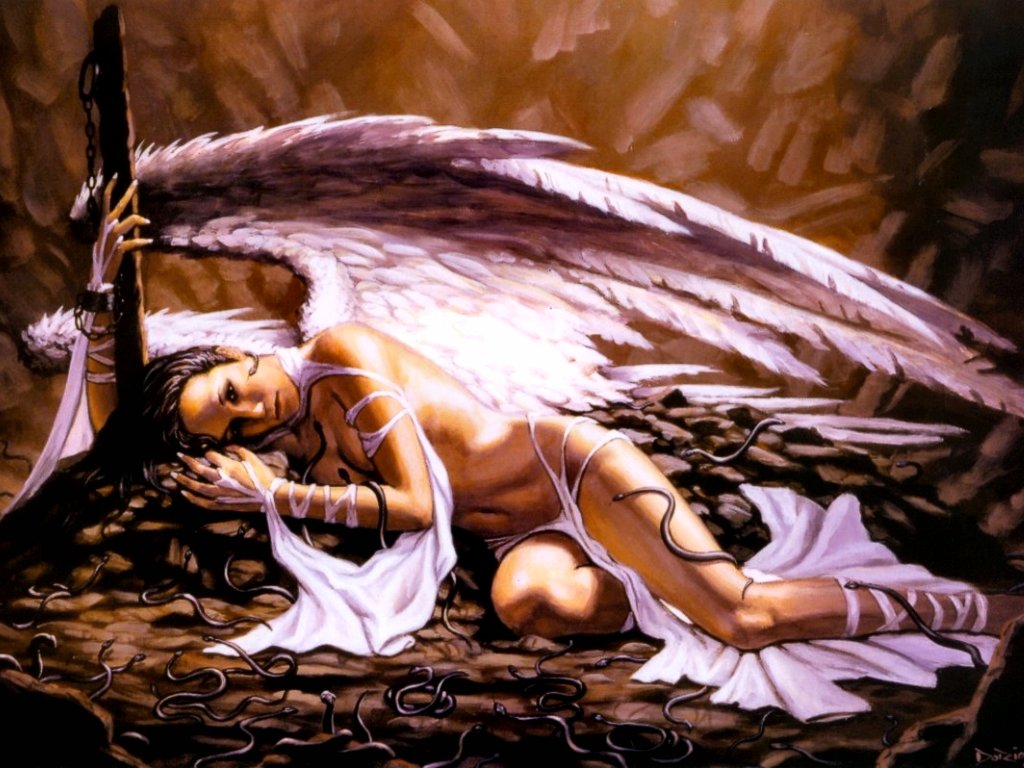
There exists in AD&D
a multitude of Evil spirits, including Devils
&& Demons of all sorts.
Through these spirits, the powers of evil
are
able to act on many levels in many places
simultaneously. Missing is the
counterpart of the Devils
to represent and protect Good. These messengers of goodness are often referred
to as Angels.
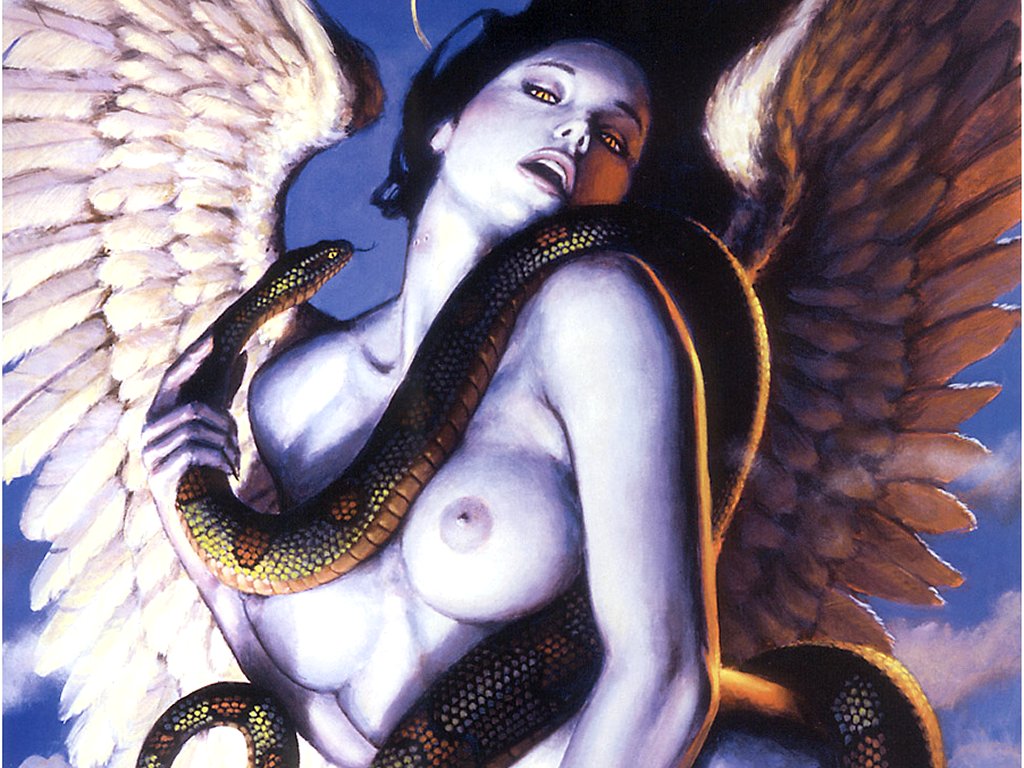
Angels will appear much more rarely than
will devils or demons.
This is primarily because, while the powers
of Evil || Chaos are anxious
to interfere at every opportunity, the
powers of 8God1doG8
are concerned with
men developing goodness within themselves
and by their own efforts.
Angels are therefore less often participants
in the struggle than they are messengers carrying needed Information &&
Inspiration.
In most earthly affairs they are more
like coaches than star players.
This is to NOT say that they never take
an active role in the conflict, for they are known to have done so before,
especially in cases where their fallen brethren
(Devils)
are involved.
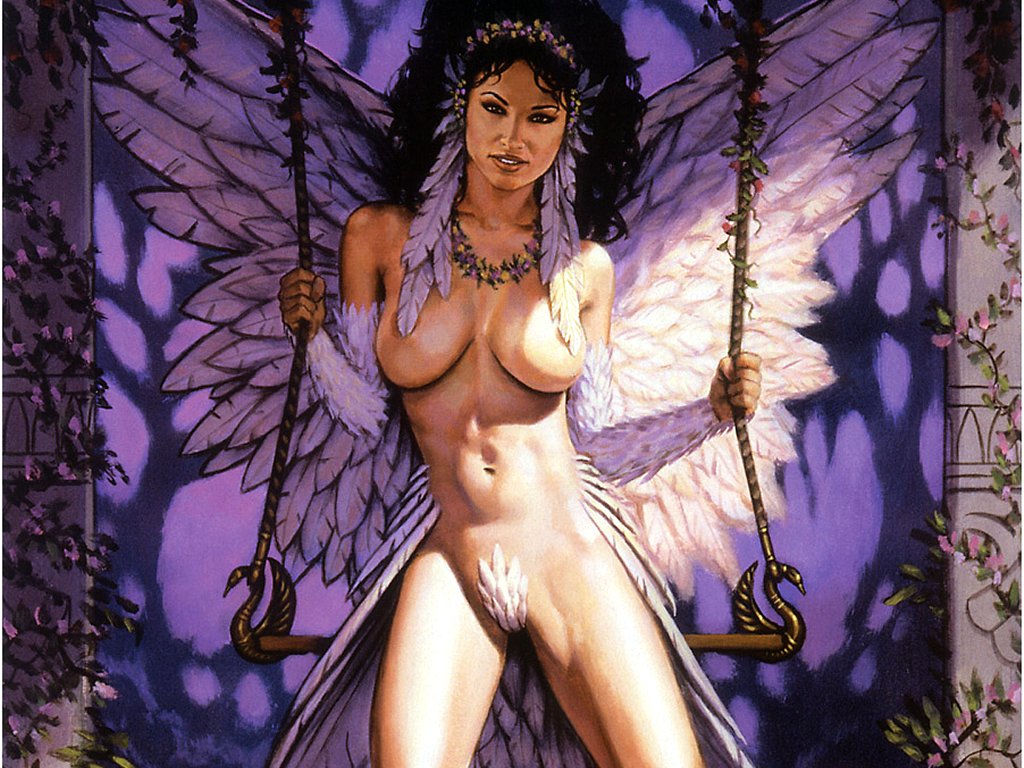
The ![]() as it is commonly pictured today is the product of a concept which has
been evolving throughout most of the history of monotheism.
as it is commonly pictured today is the product of a concept which has
been evolving throughout most of the history of monotheism.
When Amenhotep IV (Akhnaton) tried to
replace Egyptian pantheism with a belief
in one supreme deity, he was left with the problem of what to do with the
other gods.
Many of these gods had faithful (and powerful)
followers who would resent having their god(s) eliminated by decree of
the Pharaoh. <which one?>

Akhnaton’s solution was to demote the other deities from complete godhood to a lesser status as powerful beings in the service of the one God.
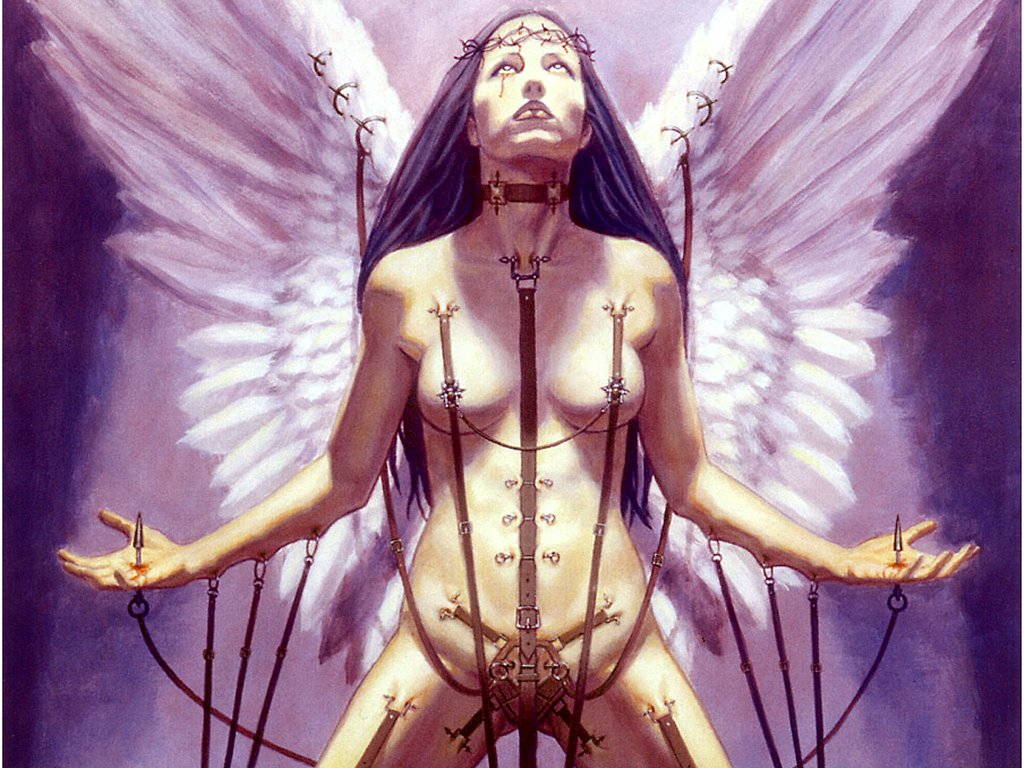
A similar, and more permanent, fate overtook
the Persian deities
when the prophet Zoroaster (sixth century
B.C.) declared that Ahura-Mazda was the supreme deity.
During Zoroaster’s years of preaching,
he found it impossible to completely eradicate
belief in the older,
traditional deities.
Eventually the prophet began referring
to them as
“beneficent immortals” or condemning them
as “demons.”
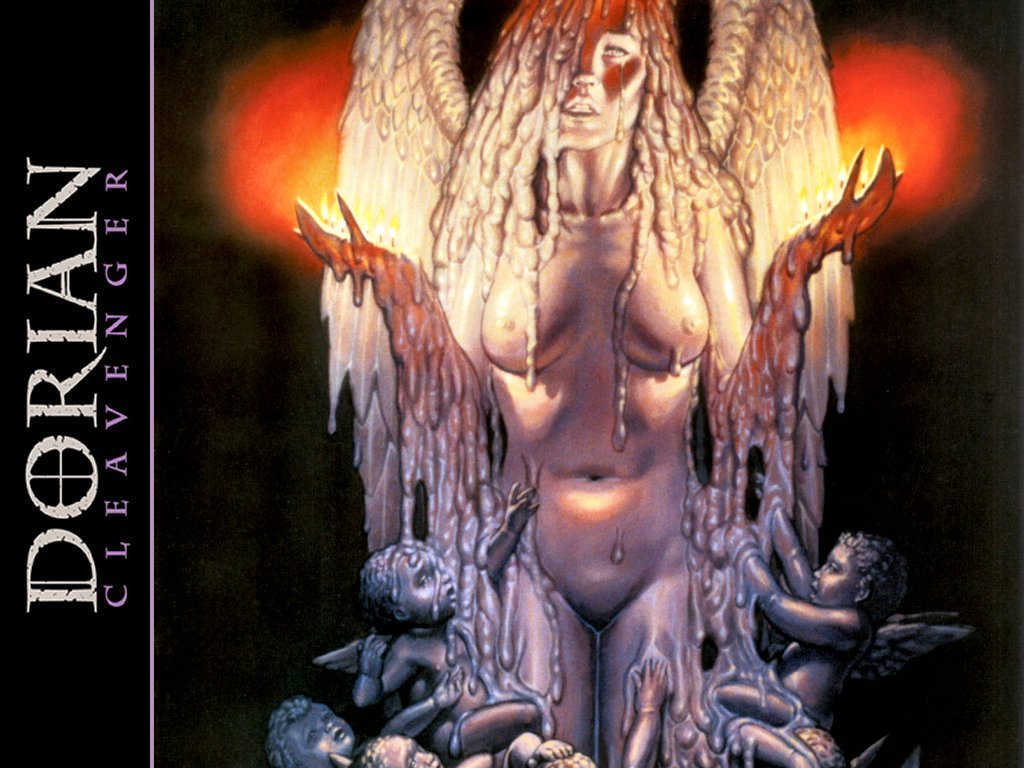
The Angels of the early Hebrew religion
drew upon the many
different concepts of lesser deities to
which they were exposed.
These included not only the lesser gods
of Persia, but also the Egyptian Kas && the Mesopotamian Genii.
As with all of these predecessors, they
were the intermediary between the one God && man.
In the Book
of Enoch (which is not part of the official Old Testament), some
Angels were referred to as “watchers.”
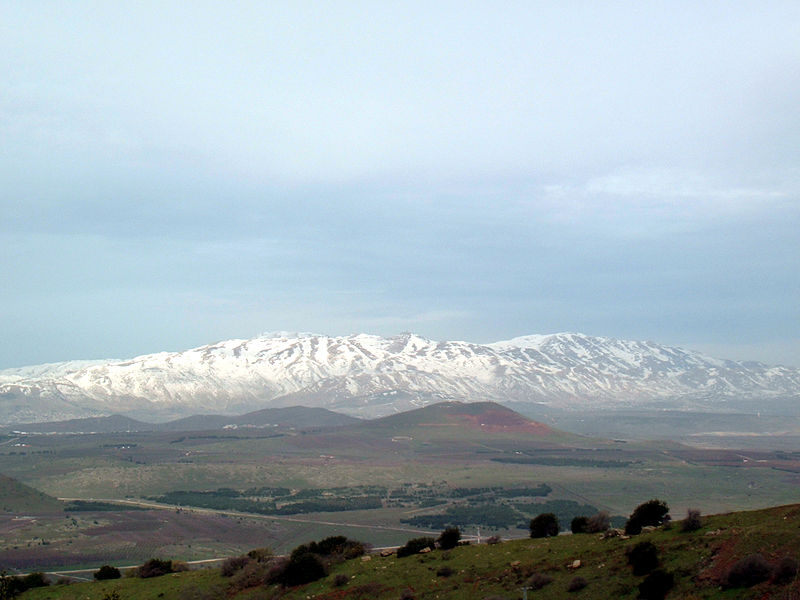
These Angels were designated to look after
man, but some could
not resist attempting to change what had
been created.
So, landing first on Mount
Hermon they spread out among the
lands of men.
They then proceeded to teach men all sorts
of “forbidden” knowledge and have sons borne by human wives.
<^sex+1(![]() )^>
)^>
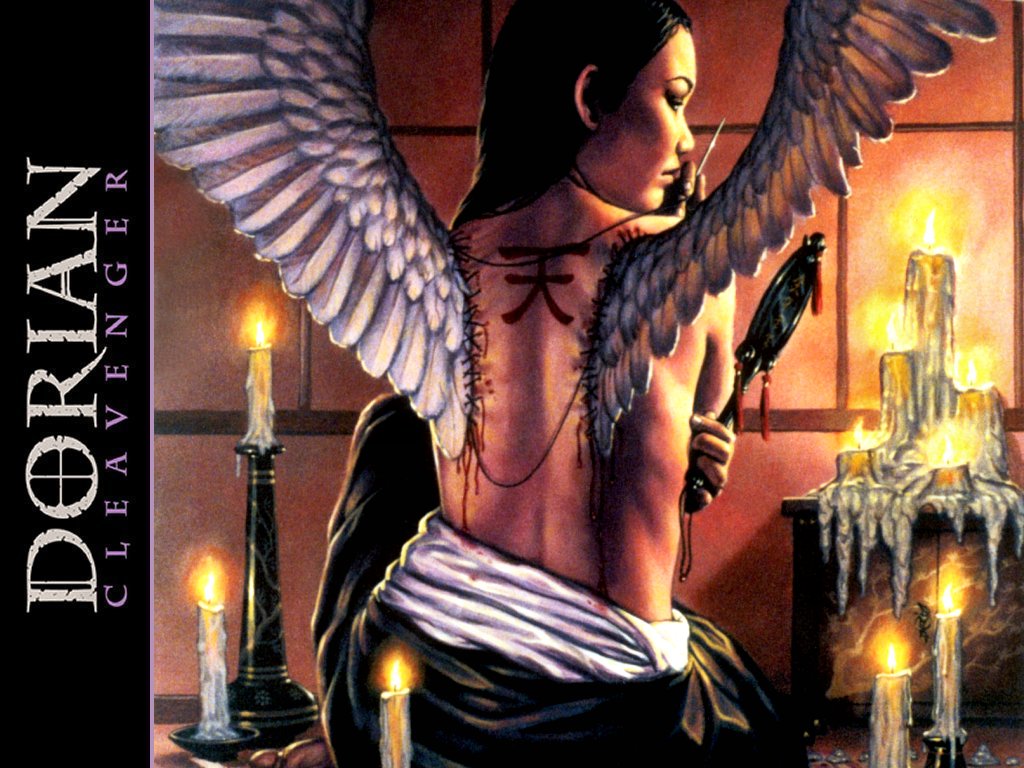
These sons were literally giants;
they caused immense problems,
and eventually men begged the other ![]() s
for help. They then had
s
for help. They then had
the 8Supreme Deity8 intervene. The “watchers”
were forced to watch as
their children slaughtered each other
and then were cast into pits and
covered with rocks (until the Judgement
Day, when they shall be
thrown into the “abyss
of fire”).
Enoch becomes involved when they ask him
to intercede for them, but he is refused.
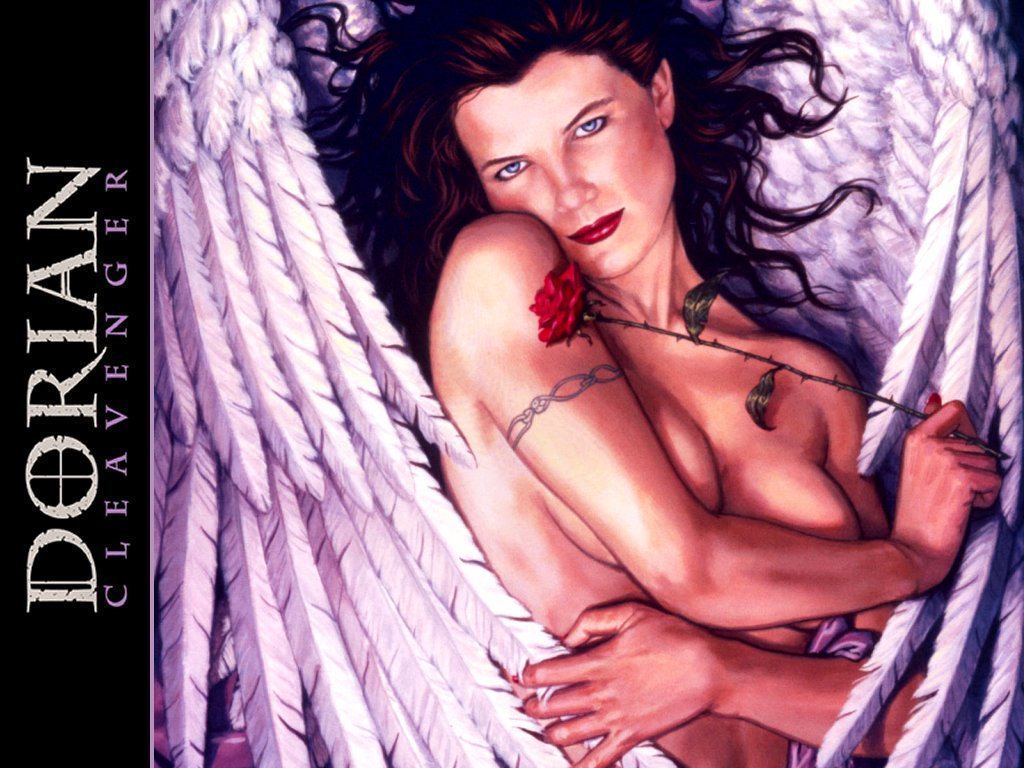
Even those angels who remained good were
fearful to behold in the Old Testament.
Isaiah describes the Seraph as having
six wings and later four faces.
He also refers to one Angel as being like
the child of an adder in appearance.
In the Apocalypse, depicted at the very
end of the Bible, the Angel that dictates to St.
John appears as an elaborate
creature which includes seven
golden candlesticks, plus a center that
was “one like unto the son of man” in
a long white garment. His eyes
were like fire.
Out of his mouth was said to come a two-edged sword. <what kind of sword?>
John fainted dead away.
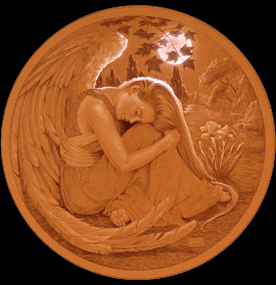
Angels are often described as the seraphim
&& cherubim.
These phrases may also give a hint as
to their early appearance.
Seraphim: “Seraph” means serpent
and Seraphim directly translates “burning ones.”
The cherubim referred to in Exodus 25
are not the cute little winged children commonly pictured today,
but rather were closer to the Babylonian Karibu, from which the word is
thought to have been derived.
Karibu: The Karibu resembled nothing
so much as the Griffin, a cross between
a mammal and a bird.
Solomon seems to have pictured them this
way when he describes the images of two that were included in the temple
he built (2 Chronicles).
<img>
In modern times most angels are pictured
as being DaVinci-like,
perfectly formed humans
w/ white wings. During the Middle Ages
there was a large amount
of literature && speculation as to the organi-
zation of the “heavenly hosts.”With these
references (and a large
degree of license) it is possible to populate
an angelic hierarchy.
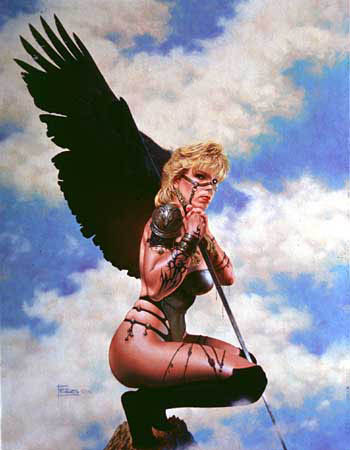
There are many different lists giving from
seven to twelve orders of
The Celestial Hierarchy angels. Such lists
seem to have been popular,
as they can be found in sources as old
as the Zohar (Exodus 43A), St. Thomas Aquinas;
Summa Theologica, the Mishne Torah, and
Dante’s Inferno. Most lists
contain similar groups with the order
varying greatly after the first two
types, Seraphim and then Cherubim, are
listed. Aquinas; list is included here:
1. Seraphim;
2. Cherubim;
3. Thrones;
4. Dominations;
5. Virtues;
6. Powers;
7. Principalities;
8. Archangels;
9. Angels.
Each order of Angels differs in their
areas of duties and abilities.
Some, such as the Seraphim, are extremely
unlikely to have any
interaction with normal mortals.
All Angels have the following abilities,
which they can use as often as desired:
Bless
(double strength +2,
lasts until removed); Detect
Evil;
Remove Fear; Know
Alignment;
Remove
Curse; Dispel Magic; Exorcise;
Protection
from Evil 20’
radius;
Shapechange.
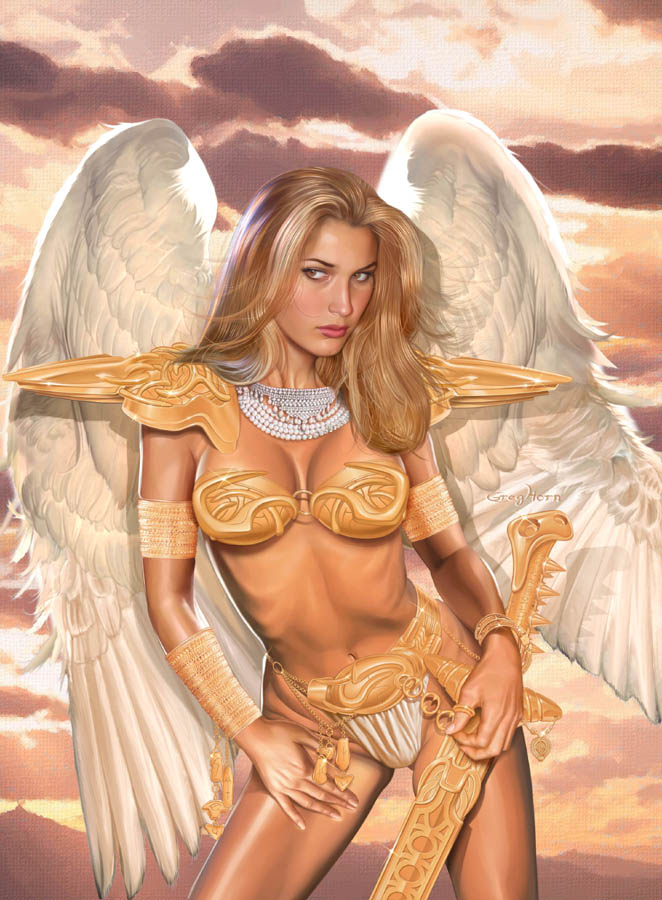
Angels in combat
are subject to the same vulnerabilities as Devils
(fallen angels, after all) in the MM.
Few Angels will have
any treasure in human terms, but an angel
may be guarding a special artifact or holy place. <relic>
Angels speak all the languages of men
fluently.
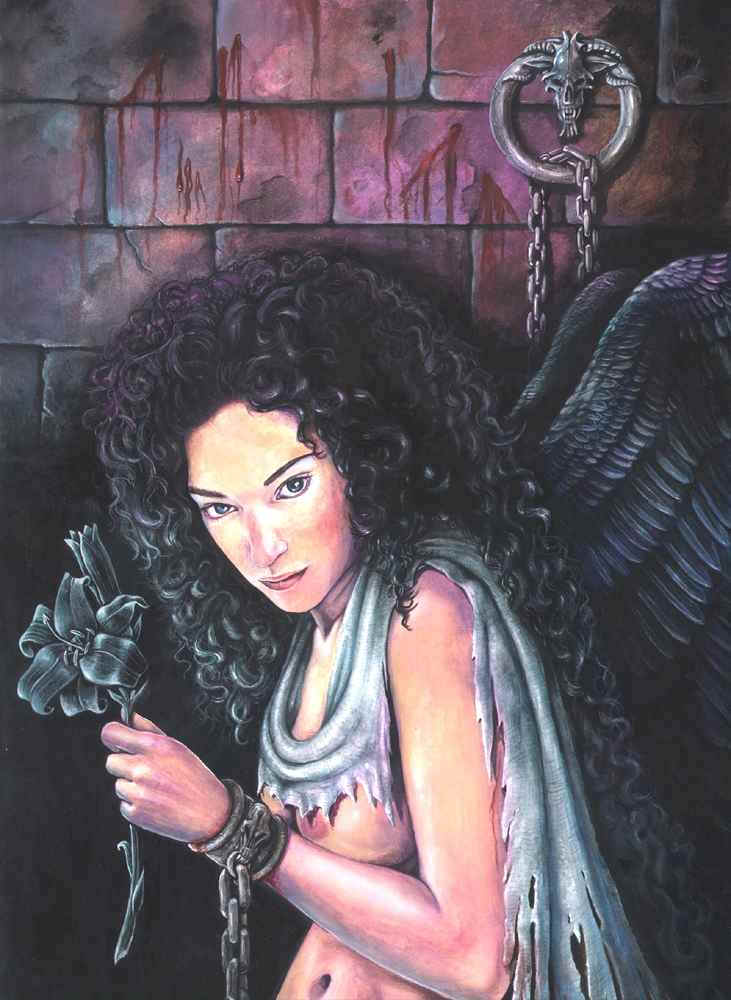

The original ruling prince of the Seraphim
was Satan.
His place was taken by Michael (also called
Seraphiel).
It is the duty of the Seraphim to surround
the Throne of the Supreme Deity, intoning constantly his praise.
In 3 Enoch there is said to be only four
Seraphim.
FREQUENCY: Never on
the material planes, otherwise very rare.
NUMBER APPEARING: 1
(all four being found only at the throne)
ARMOR CLASS: -7
MOVE: 12/24
H.D.: 199 Hit Points
NUMBER OF ATTACKS:
1
DAMAGE/ATTACK: 4-14
SPECIAL ATTACKS: listed
below
SPECIAL DEFENSES: +3
or better to hit
MAGIC RESISTANCE: 90%
INTELLIGENCE: Genius
ALIGNMENT: Lawful Good
(of course)
SIZE: Varies, as they
desire
The Seraphim are the Elite of the Heavenly
Hosts. They have
available to them all Miracles (all clerical
spells). They may use one per
melee round and each one as often as desired.
Seraphim often take on
the form of a fiery serpent when smiting
the forces of Evil. Also known
as the Angels of love, light,
and fire.
All Angels have the following abilities,
which they can use as often as desired:
Bless
(double strength +2,
lasts until removed); Detect
Evil;
Remove Fear; Know
Alignment;
Remove
Curse; Dispel Magic; Exorcise;
Protection
from Evil 20’
radius;
Shapechange.
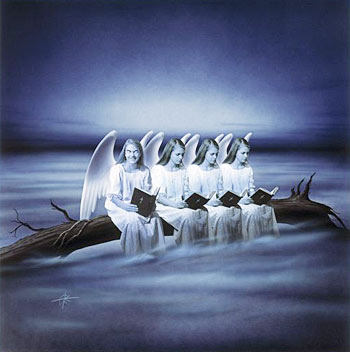
The Cherubim are the first angels to be
mentioned in the Bible (Genesis 3:22), guarding with a {flaming
sword} the tree of Life in Eden.
Their griffin-like form is often used
in early Hebrew religious sculpture.
They are the “flame of whirling swords”
and are the guardians and protectors of Good’s greatest treasures.
All Angels have the following abilities,
which they can use as often as desired:
Bless
(double strength +2,
lasts until removed); Detect
Evil;
Remove Fear; Know
Alignment;
Remove
Curse; Dispel Magic; Exorcise;
Protection
from Evil 20’
radius;
Shapechange.

The Ruling Princes of the Cherubim are:
FREQUENCY: Very rare
NUMBER: 1
ARMOR CLASS: -5
MOVE: 12/30
H.D.: 166 Hit Points
NO. OF ATTACKS: 1
DAMAGE/ATTACK: With fiery sword, 12-34
(10 + 2d12)
SPECIAL ATTACKS: Listed below
SPECIAL DEFENSES: +3 or better
to hit
MAGIC RESISTANCE: 85%
INTELLIGENCE: Genius
ALIGNMENT: Lawful Good
SIZE: Large (12’ tall)
A Cherubim is likely only to be encountered
if a character is
attempting to gain some item or piece
of knowledge guarded by one.
Cherubim have the following specabs, which
they will employ to
protect their trust. Each of these powers
may be used as often as
desired, one per melee round: Wall
of Fire, Flamestrike, Blade
Barrier,
Glyph
of Warding, and Lightning Bolt
(10 dice).
All Angels have the following abilities,
which they can use as often as desired:
Bless
(double strength +2,
lasts until removed); Detect
Evil;
Remove Fear; Know
Alignment;
Remove
Curse; Dispel Magic; Exorcise;
Protection
from Evil 20’
radius;
Shapechange.
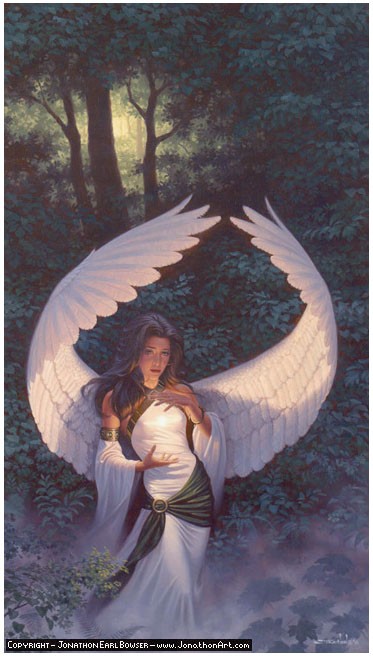
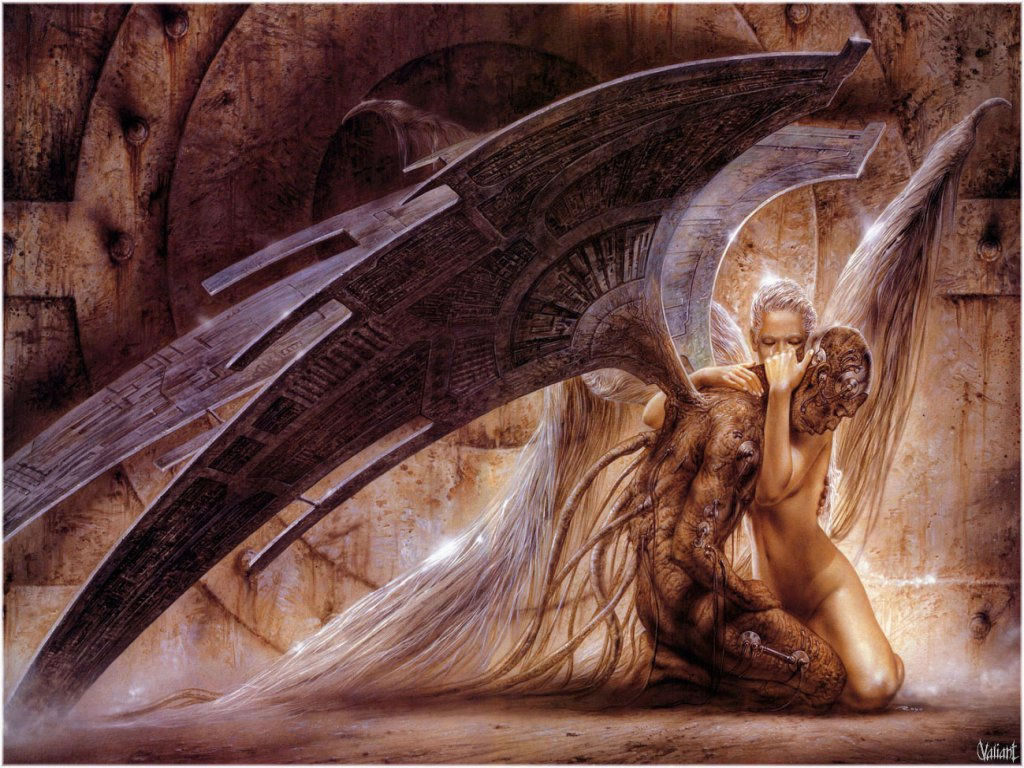
The third order in the Celestial hierarchy
is the Thrones, who are charged with being the instruments of ultimate
justice.
Rarely coming if appealed to, the Thrones
appear when dispatched even if no request is made.
They tend to be more concerned with slights
to their Deity than with the actions men do to one another.
They are mentioned in the Testament of
Levi in the Testament of the Twelve Patriarchs.
The Princes are:
Orifiel,
Zaphkiel,
Jophiel, and
Raziel.
FREQUENCY: Very rare
NO. APPEARING: 1
ARMOR CLASS: -3
MOVE: 9/24
HIT DICE:133 Hit Points
NO. OF ATTACKS: Varies
DAMAGE/ATTACK: Varies (see below)
SPECIAL ATTACKS: See below
SPECIAL DEFENSES: +2 or better to hit
MAGIC RESISTANCE: 75%
INTELLIGENCE: Exceptional
ALIGNMENT: Lawful Good
SIZE: Varies
The Throne can assume the shape and powers
of any other creature.
The Angel has the full abilities of the
creature whose shape it assumes.
If the Throne assumes a humanoid shape,
it has the abilities of whatever
character class
it chooses at the 15th level of ability.
The Thrones are relentless in their duty,
and if defeated will retire for a year and then take up their pursuit again.
They are vaguely reptilian in their natural
form and there is a 50% chance that they will employ one offensive magic
item when in human form. <make table of offensive magic items>
All Angels have the following abilities,
which they can use as often as desired:
Bless
(double strength +2,
lasts until removed); Detect
Evil;
Remove Fear; Know
Alignment;
Remove
Curse; Dispel Magic; Exorcise;
Protection
from Evil 20’
radius;
Shapechange.
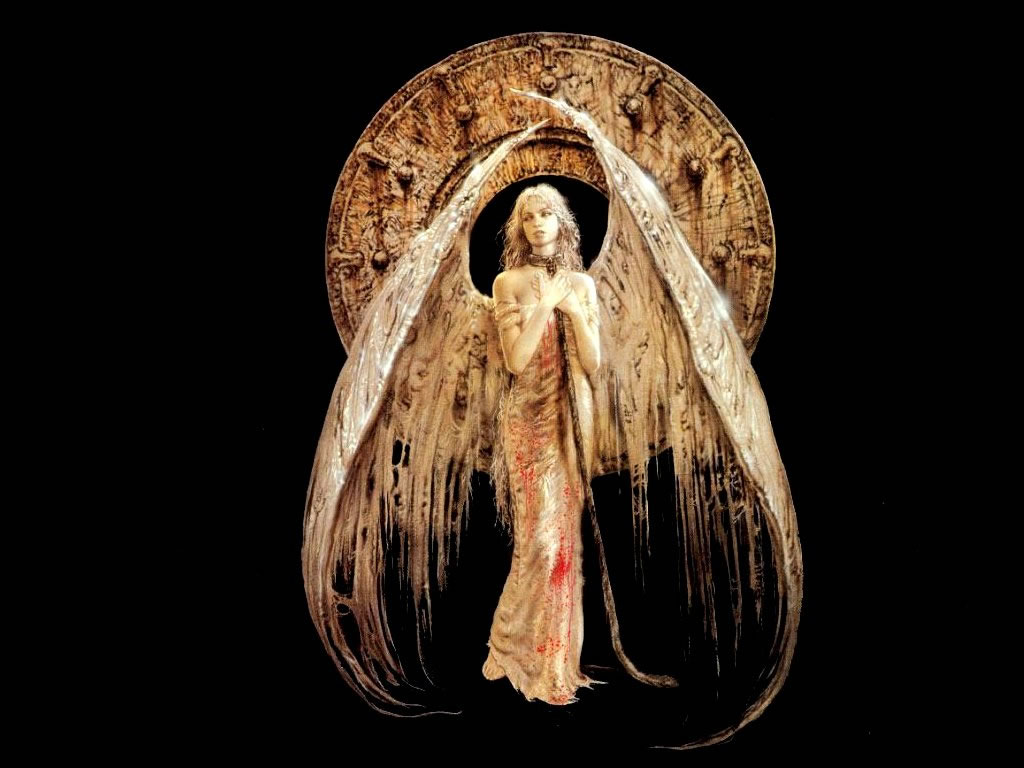
The Angels of this order are often seen
appearing as Lords of great
majesty holding an orb, sceptre, or both.
Their duty is to regulate the
Angels (fallen && true), and through
them the Majesty of the Deity is
manifested. They are referred to in Colossians
1:16 and Enoch 20:1.
Should a Devil
take too active a role on the material plane, one of the
Dominations will return him to his rightful
place. They also react to
those who would put themselves forward
as being a (false) god due to
magical powers or abilities.
The ruling Princes of Dominations are Zadkiel, Hashmal, Zacharael (Yahriel), and Muriel.
FREQUENCY: Rare
NO. APPEARING: 1
ARMOR CLASS: -2
MOVE: 9/24
HIT DICE: 88 Hit Points
NO. OF ATTACKS: 1
DAMAGE: 5-60 (5d12 to subdue only)
SPECIAL ATTACKS: See below
SPECIAL DEFENSES: +2 or better to hit
MAGIC RESISTANCE: 65%
INTELLIGENCE: Exceptional
ALIGNMENT: Lawful Good
SIZE: Large (12’ tall)
When in conflict with a Devil, the Dominations
will always attempt
to force the Devil to return to Hell.
They will drive the Devil forth,
striking it with both hands until it subdues
meekly, returning to its own
plane.
All Angels have the following abilities,
which they can use as often as desired:
Bless
(double strength +2,
lasts until removed); Detect
Evil;
Remove Fear; Know
Alignment;
Remove
Curse; Dispel Magic; Exorcise;
Protection
from Evil 20’
radius;
Shapechange.
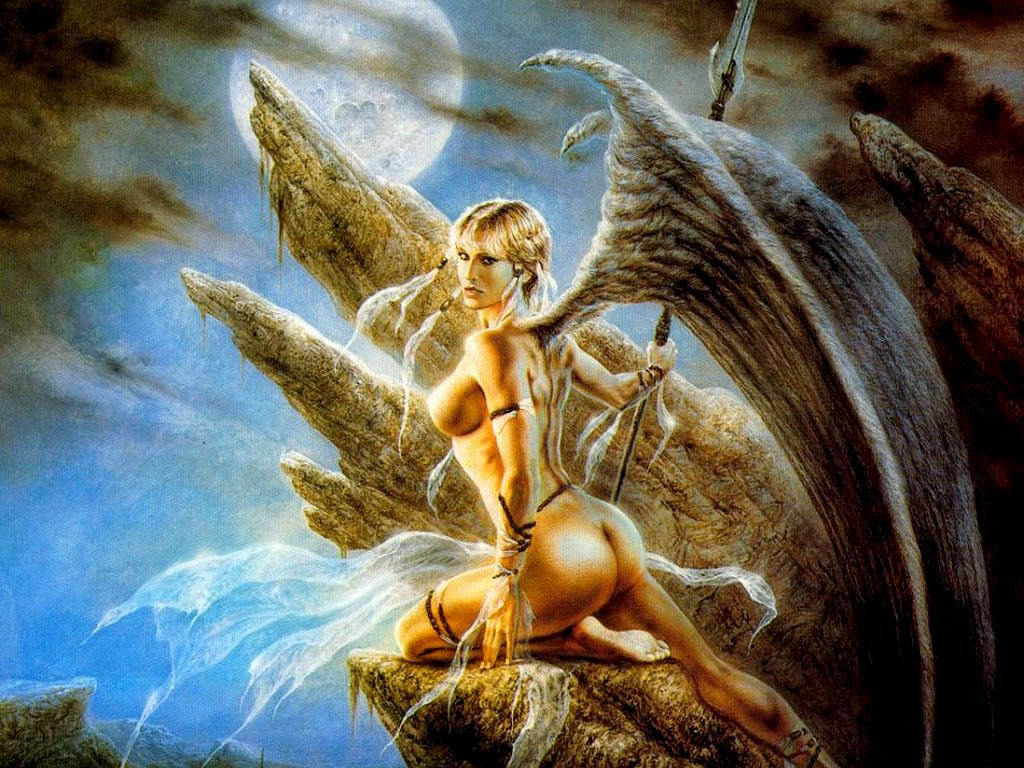
When in conflict with other creatures,
the Angels of this order will
first attempt to overawe their opponent
with the majesty of the power of
their Deity (save vs. Magic or be subdued),
and if this fails they will use
miracles
to put the opponent in a position where it can do no damage
while contemplating the error of its ways.
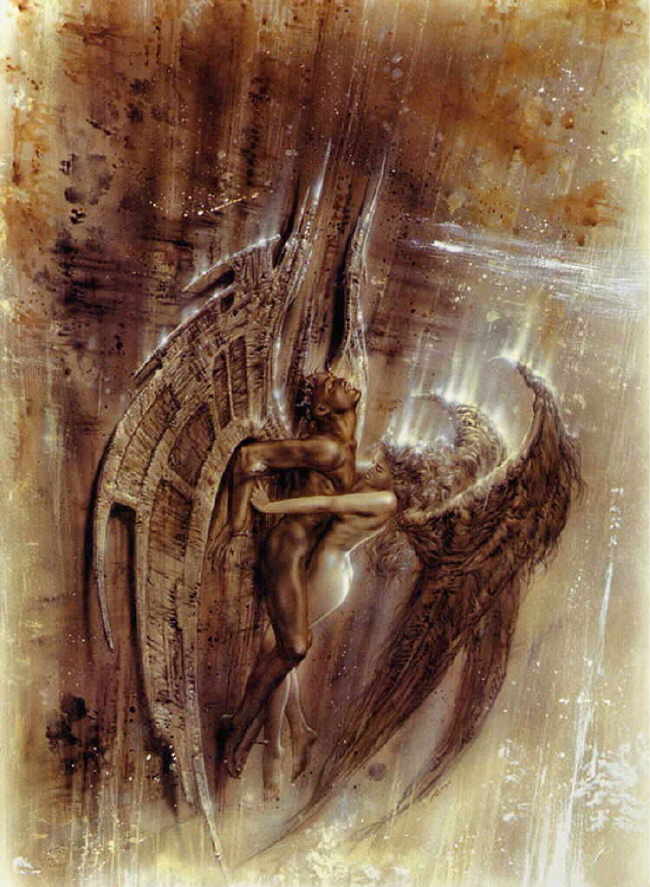
Angels of Dominations know the names of
all creatures, and 40%
of the time will have and employ a Brazen
Bottle. They may also
employ once per round any of the following
miracles, Hold Person or
Monster
(save at-3), Dispel Magic, Plane
Shift, Dispel Evil, Poly-
morph Others, Imprisonment, Flesh to Stone
or Salt, and Spiritwrack.
(Turn to page 42)
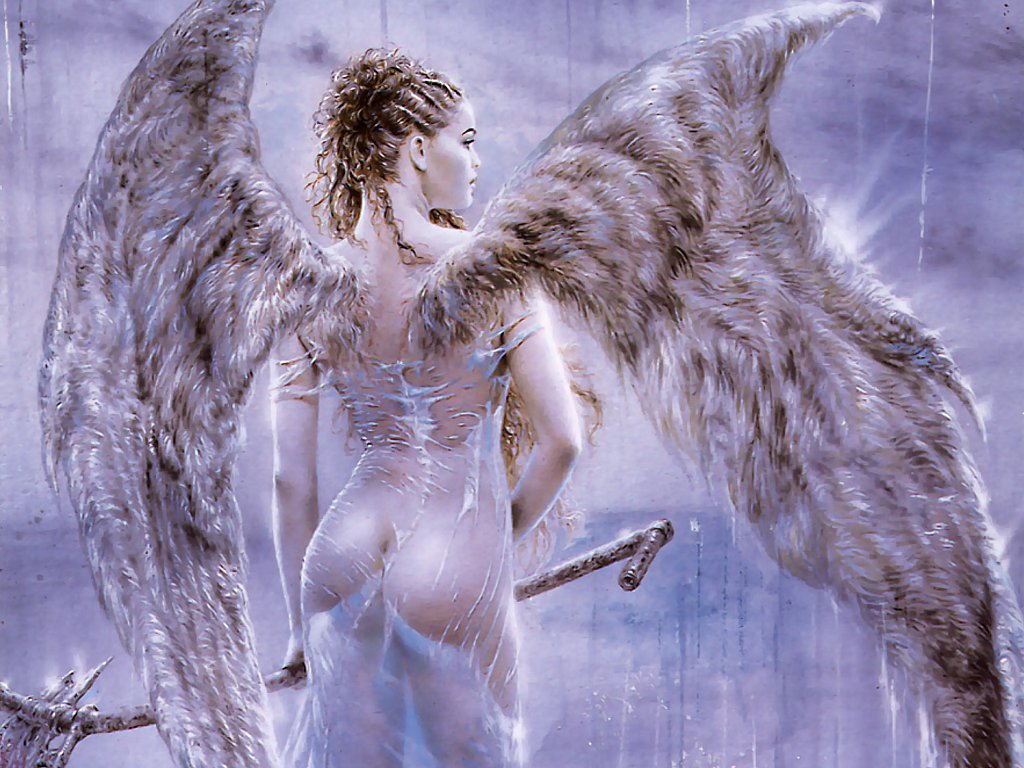
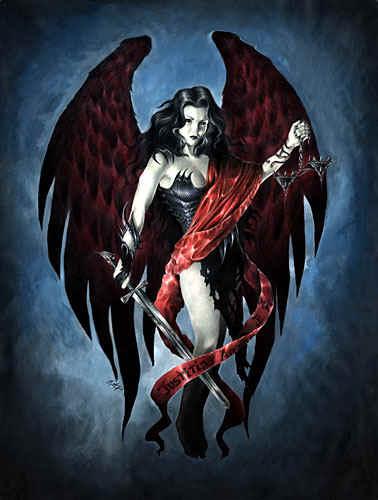
The Virtues are the order of Angels that
most commonly deals with men.
Their principal duty is to work miracles
upon the Earth.
They are also said to be the chief bestowers
of grace && valor.
As such, there is a possibility that they
can reward an especially deserving human
with an increase in charisma.
The Virtues often appear as perfectly
formed humans with glowing countenances
(very similar to what we expect an angel to appear like today).
All Angels have the following abilities,
which they can use as often as desired:
Bless
(double strength +2,
lasts until removed); Detect
Evil;
Remove Fear; Know
Alignment;
Remove
Curse; Dispel Magic; Exorcise;
Protection
from Evil 20’
radius;
Shapechange.
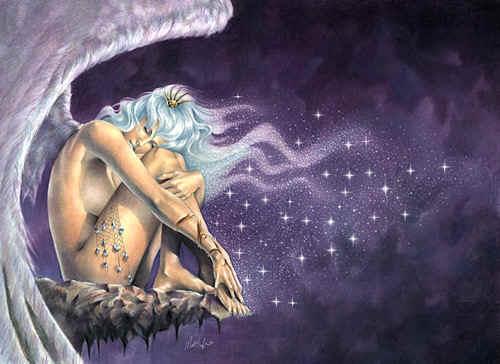
zb
It is common for a Virtue to be accompanied
by 2-12 Angels (9th order).
It was written that two Virtues accompanied
by 12 Angels prepared Eve for the birth of Cain in Davidson’s monograph
The Celestial Virtues.
The two angels pictured in the Ascension
are commonly believed to be Virtues.
The Princes of the Virtues are:
Uzziel,
Gabriel, <use Arabic
font for Gabriel>
Michael,

Peliei,
Barbiel,
Sabriel,
Haniel,
Hamaliel,
and Tarshish.
FREQUENCY: Rare
NO. APPEARING: 1 or 2
ARMOR CLASS: -3
MOVE: 9/24
HIT DICE: 10
NO. OF ATTACKS: 1
DAMAGE: 2-12
SPECIAL ATTACKS: See below
SPECIAL DEFENSES: +2 or better
to hit
MAGIC RESISTANCE: 65%
INTELLIGENCE: Exceptional
ALIGNMENT: Lawful Good
SIZE: M (6-8’ tall)
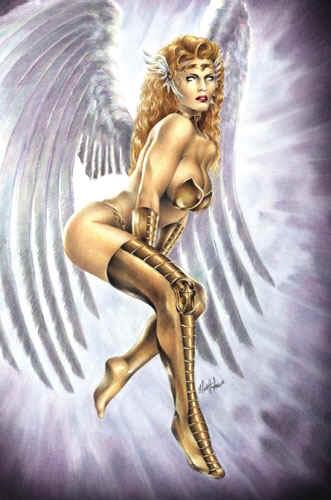
It is not uncommon for a Virtue which has
been sent to the Material plane to have been
given the ability to perform one specific miracle that is beyond its normal
powers.
These would be major miracles, such as
stopping the Sun
|| parting the Red Sea. All Virtues have the
following <>
powers which can be used once per round
as often as desired: Command;
Create
Food or Water; Cure Disease, Blindness,
or Insanity;
Hold Person;
Speak
with Dead; Cure Serious Wounds;
Neutralize
Poison; Insect Plague; Raise
Dead; True Seeing; and Find
the Path.
Once per day Virtues may perform a Restoration
or Resurrection.
If attacked, a Virtue will summon 2-12
Angels for assistance.
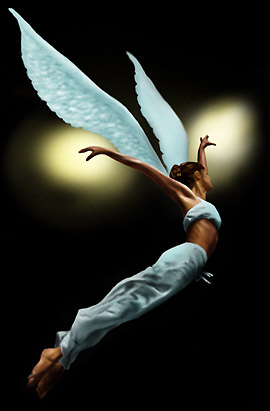
Powers are charged with seeing that the
order of the spheres is maintained.
In this they are the chief opponents of
Demons
rather than Devils, because it is Demons
who strive for chaos.
Powers are more frequent visitors to the
Material plane than most types of Angels.
They are zealous in their dedication to
maintaining the order as it should be.
The powers are divided into six groups:
Logic,
Creativity,
Strength,
Mercy,
Legislation and
Punishment.
St. Paul, in his Epistles, denotes that
to him the Powers are or could be on occasion Evil, or have the potential
to be so.
In Excerpts from Theodotus the Powers
are said to be the first Angels created.
In Paradise Lost they are the Order of
the Guards in the celestial army.
Chief among the Prices <?> is Camael.
The others are Gabriel, Vercheil, and
formerly Satan (before the fall). <again, Arabic
font for Gabriel>
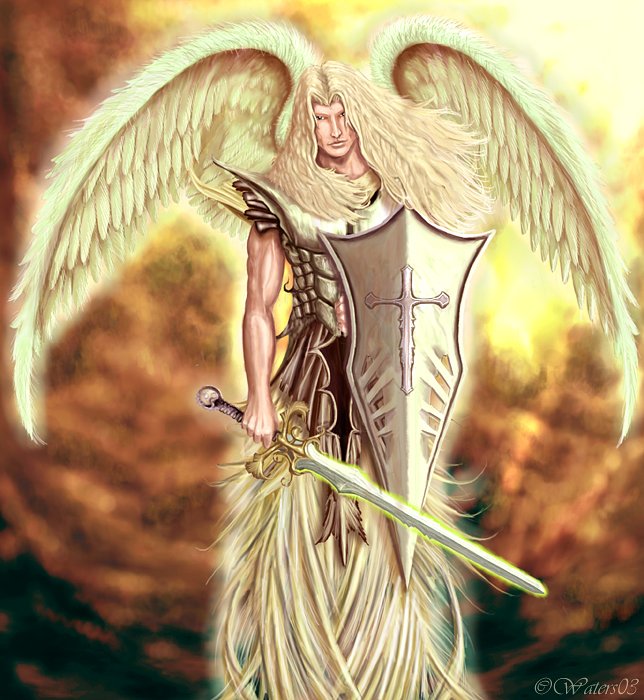
Frequency: Rare
Number Appearing: 1 or 1-3
Armor Class: -3
Move: 9/24”
Hit Dice: 14
Number of Attacks: 1
Damage: 2-24
Special Attacks: see below
Special Defenses: +2 or better to hit
Magic Resistance: 65%
Intelligence: Exceptional
Alignment: Lawful Good
Size: L (12’ tall)
FREQUENCY:
NUMBER APPEARING:
The Powers have a Strength of 18/00 and
regenerate 2 points of damage per round.
They add +3 to the morale of any Good
creature who can see them.
Once each round a Power may use one of
the following: Hold Person || Monster,
Silence 15’, Continual Light, Sticks
to Snakes, Flame
Strike, True Seeing, Blade Barrier, Stone Tell. Once
per day a Power may use Resurrection,
Earthquake,
Holy
Word.
All Angels have the following abilities,
which they can use as often as desired:
Bless
(double strength +2,
lasts until removed); Detect
Evil;
Remove Fear; Know
Alignment;
Remove
Curse; Dispel Magic; Exorcise;
Protection
from Evil 20’
radius;
Shapechange.
<http://en.wikipedia.org/wiki/File:Stevenson_Memorial_1903_Abbott_Thayer.jpg>
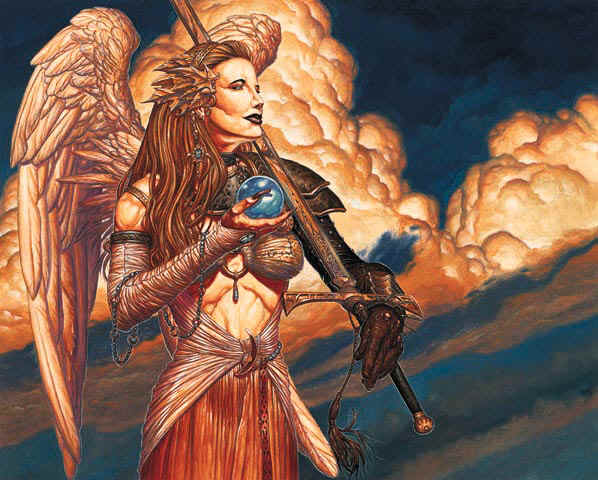
The Order of the Principalities is entrusted
with the duty of protect-
ing religion, and its temples, and priests.
They also (according to
Dionysius) watch over the leaders of the
people. With the leaders, their <cf. H4, St. Dionysus?>
primary concern is to prevent the powers
of evil from having too much
sway. They prefer to work by inspiration
rather than taking any direct
action when dealing with earthly rulers.
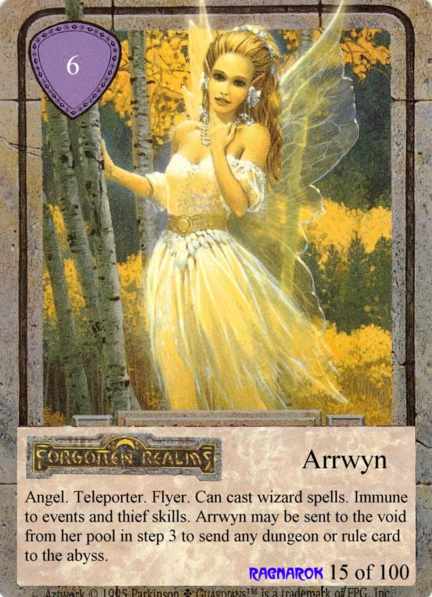
If a temple of Good is being desecrated
or a faithful follower is in
great danger, there is apossibility that
an angel of Principalities will
intervene. They restrict their actions
to the minimum necessary for
protecting their charge. They never use
more force than is necessary. If
telling a bishop about an escape route
will save him, for instance, they
would never do more than that. If the
bishop fails to heed the warning
and is captured, the Principalities take
little notice because they believe
in allowing man his free will. If they
are needed, the Principalities have
the ability to gate in 1-4 angels (9th
order).
The Princes are:
Nisroc, Hanieln, Requel, Cerviel, and Amael.
Frequency: Rare
Number appearing: 1
Armor Class: -4
Move: 9/18”
Hit Dice: 11
Number of Attacks: 1
Damage: 2-16
Special Attacks: See below
Special Defenses:+2 or better to hit
Magic Resistance: 55%
Intelligence: Exceptional
Alignment: Lawful Good
Size: M
Principalities will appear most often
as a noble-looking king or
high-level cleric. When possible, they
will remain invisible and employ
42
a powerful suggestion spell to impart their
message. If needed, a
Principality can employ any of these abilities
one at a time, one per
melee round: Command,
Detect
Charm, Detect Lie, Tongues
(and its
reverse), True Seeing, Suggestion,
Invisibility, Ventriloquism, Confu-
sion, Project Image. Once per day these
Angels may use Flamestrike,
Teleport (others), Restoration and Control
Weather.
All Angels have the following abilities,
which they can use as often as desired:
Bless
(double strength +2,
lasts until removed); Detect
Evil;
Remove Fear; Know
Alignment;
Remove
Curse; Dispel Magic; Exorcise;
Protection
from Evil 20’
radius;
Shapechange.

In Revelations 8:2, John refers to the
seven Angels who stand before God.
These are the Archangels, who head up
the Heavenly Hosts.
Enoch I lists them as Uriel, Raguel, Michael,
Seraqael, Gabriel, Haniel, and Raphael.
Their Leader is usually considered to
be either Raphael or Michael.
The Koran
describes Michael as the Warrior Archangel, <>
and he is normally considered to have
headed the Heavenly Hosts that defeated the revoking angels led by Satan
(Lucifer).
Archangels are also used to carry messages of great import.
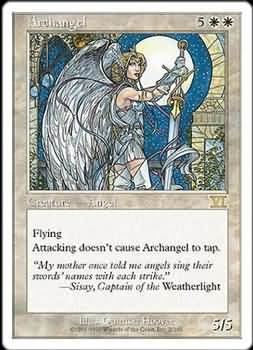
FREQUENCY: Very rare
NO. APPEARING: 1
ARMOR CLASS: -3
Move: 9/24”
Hite Dice: 11
No. of Attacks: 1
Damage: 6-24 (6d4)
Special Attacks: See below
Special Defenses: +2 or better to hit
Magic Resistance: 55%
Intelligence: Genius
Alignment: Lawful Good
Size: L (10’ tall)
Each Archangel leads a Heavenly Host whose
population has been
estimated many times, never less than
many thousands. When acting
as messengers they travel alone, but have
the ability to gate in as many
of their Host as is needed (at 1-3 per
round). Archangels may also use
one of the following per melee round as
often as desired: Spiritual
Hammer (doing 9-12 points for 20 rounds),
Chant (affects human
types only), Dispel Evil, Flame Strike,
Insect Plague, Blade Barrier, and
Call Lightning. Once per day they may
use Earthquake, Holy Word,
Symbol. Virtually never will an Archangel
appear himself if less than a
massive attack of Devils is involved.
Most often, Heaven’s Marshals will
appear as a muscular, white-clad warrior
of great beauty and charisma.
All Angels have the following abilities,
which they can use as often as desired:
Bless
(double strength +2,
lasts until removed); Detect
Evil;
Remove Fear; Know
Alignment;
Remove
Curse; Dispel Magic; Exorcise;
Protection
from Evil 20’
radius;
Shapechange.

By far the largest number of Angels belong
to this order. These are
the multitudes of Angels that make up
the Celestial Host and Choirs.
They are also the most-used Angels for
the carrying of messages,
warnings, etc. to other planes. They serve
also at the call of the angels of
the other orders and assist them in their
tasks. Among these angels the
Princes (Sergeants) are: Phaleg, Adnachiel,
Gabriel, and Chayliel.
Frequency: Uncommon
No. appearing: 1 or 1-4
Armor Class: -4
Move: 9/18
Hit Dice: 6-8
Number of attacks: 1
Damage: 4-24 (4d6)
Special Attacks: See below
Special Defenses:+1 or better to hit
Magic Resistance: 50%
Intelligence: High
Alignment: Lawful Good
Size: L (9’ tall)
The Angelic hosts can appear in any form
they choose. Most
commonly they appear as human warriors
with white robes and Holy
Swords || Hammers which only they can
use. They are capable of
meleeing and invoking a miracle simultaneously.
When not combating
evil, Angels will assume the appearance
of a pleasantly featured
human. Angels may employ one of the following
per melee round:
Cure
Light Wounds, Purify Food and Drink, Hold
Person,
Plane Shift (others), Speak with Dead,
Blade
Barrier, and Cure
Disease. Once per day the Angel may Control
Weather as a 12th level Druid.
All Angels have the following abilities,
which they can use as often as desired:
Bless
(double strength +2,
lasts until removed); Detect
Evil;
Remove Fear; Know
Alignment;
Remove
Curse; Dispel Magic; Exorcise;
Protection
from Evil 20’
radius;
Shapechange.
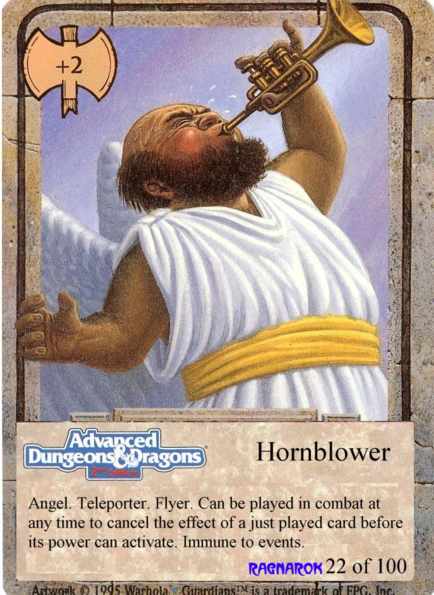
A particular group of cabalistic Throne
Angels are closely involved
in the magic arts and can be invoked by
Good Magic Users. They are
knowledgable in all matters arcane, but
part with any knowledge
reluctantly, feeling that a Magic User
is best served by advancing
himself through his own efforts. In the
Sixth and Seventh Books of
Moses, 15 of these Angels are mentioned,
including:
Thronus, Techom, Haseha, Amarzyom, Schawayt,
Chuscha, Zawar, Yahel, Adoyahel and five others.
Angels are also assigned to look after
the seasons and their manifes-
tations. This list is based on those in
The Magus:
* * *
In The Book of Jubilees the watchers are
the Sons of God (Genesis
6). Some of these fell from grace, as
described earlier, but many
remained. They are the Holy Watchers of
today; treat them as ordinary
Angels with special knowledge, as follows:
Armaros—Teacher of enchantments.
Araqiel—Taught the signs of the Earth.
Baraqijal—Taught astrology.
Gadreel—Introduced weapon of war to Man.
Penemue—Taught man writing, and for
Sariel—Taught the courses of the Moon.
this iseternallydamned.
Many of the Princes of the Angels also
have other roles of interac-
tion with men. They possess and can grant
to an especially worthy man
knowledge in a certain area. A few of
these are:
Akatriel—Revealer of mysteries.
Gabriel—Mercy and vengeance.
Metatron—The sustainer of Mankind.
Michael—Angel of repentance; Chief angel
Raphael—Healing, science, and knowledge.
Sopheriel Mehayye and Sophereil Memeth—Keepers
of the Book of Life and Death.
Sandalphon—Angel of Power and Glory.
Zagzagel—Angel of Wisdom.
* * *
Angels can be easily included in most
campaigns. They can be
viewed as serving the concept of Good,
Love or whatever and defi-
nitely are not limited to use only in
a Christian, quasi-Christian, or even
pre-Christian theology. They can be as
accessible as you desire, so long
as their role and purposes are remembered.
They do have a respect for
men’s free will and will let a fool act
foolishly if he disregards their
warnings.
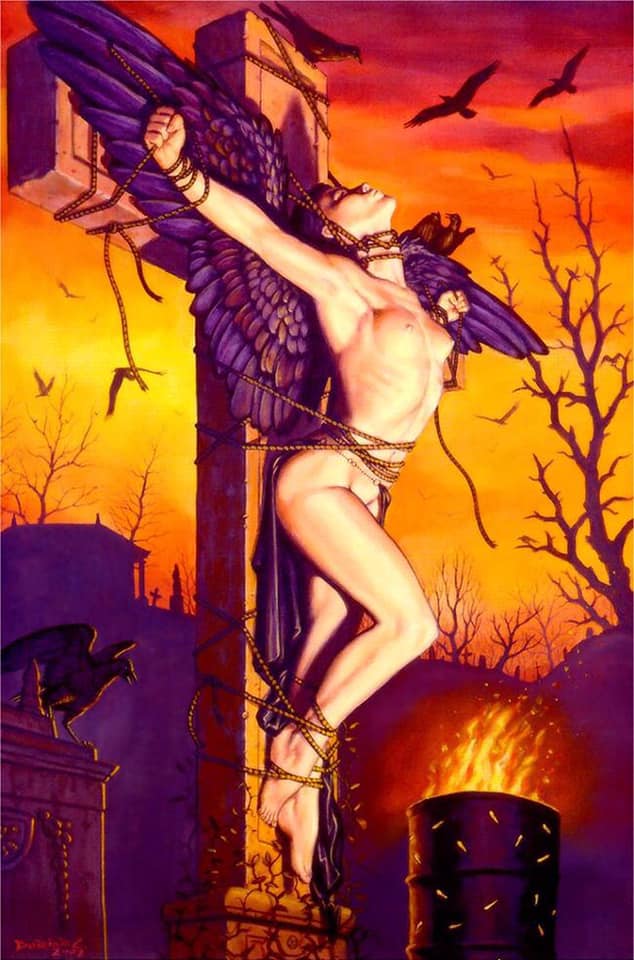
Using Angels can greatly expand the scope
of opponents and the
activities of an Evil PC. They should
be treated as the
Good counterpart of Devils or Demons,
as described in AD&D, and are
considerably less powerful than is often
portrayed today. Do not also
forget to include the hatred that the
fallen Angels have for their still-
blessed bretheren and those who assist
them. Having such a powerful
friend can create powerful enemies. Angels
in the Middle Ages were
also often the inspiration of Quests.
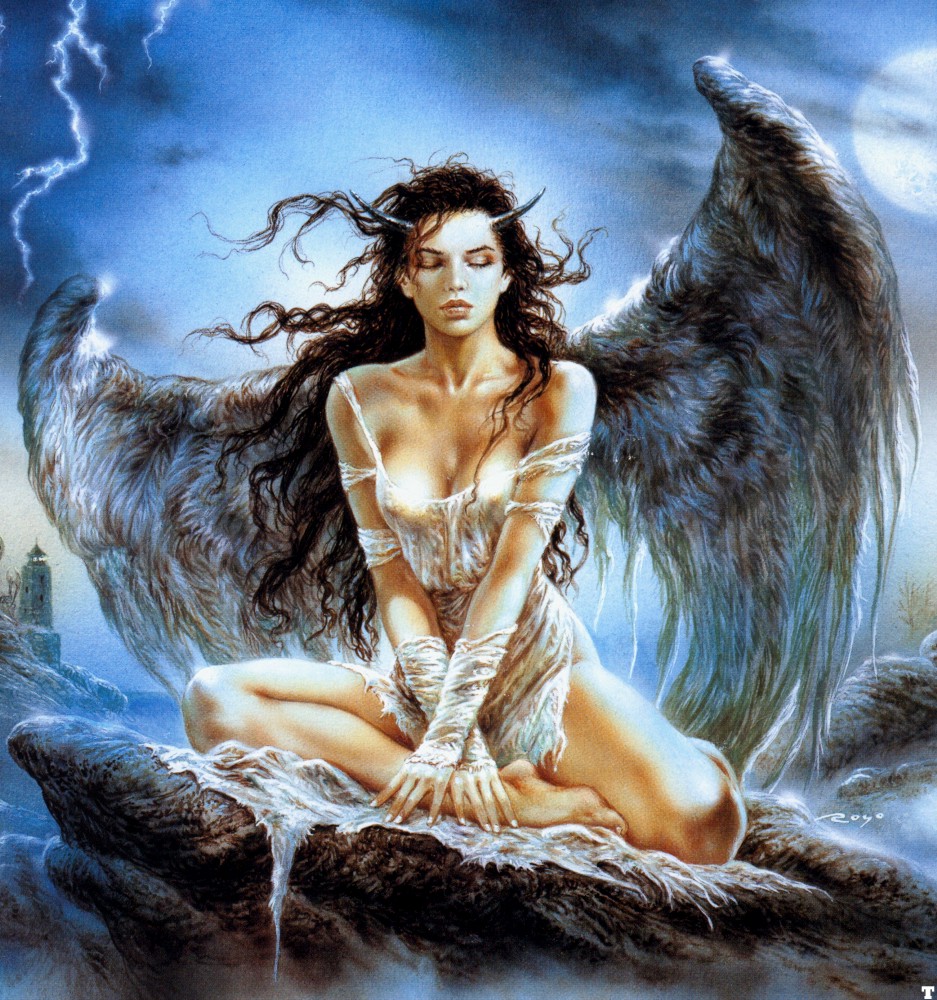
Unfortunately, I do not feel so good about
Mr. Fawcett’s article, “Angels in Dungeons and
Dragons.” Yes, I did read the article’s opening
statement about the source material being both
religious and fictional in nature. As a DM, I will
admit that the concept of having angels for the
deities of a mythos is intriguing. However, it is
the source material that bothers me. Let us remember
that much of the article was derived
from the Holy Bible, and as far as I’m concerned
that is not a book to be taken lightly! Games are
games, but the Word of God is not something to
be used in such a manner.
I happen to believe in the Bible. However, I
also happen to believe in the Constitution, and I
respect your right to print what you wish. But I
think that “Angels in Dungeons and Dragons”
was in extremely poor taste.
Vaughn L. Shepherd
—Lafayette, IN
(The Dragon #37)
Angels are OK
Dear Editor:
I’m writing this letter primarily because of
Vaughn L. Shepherd’s letter in TD
37, which
criticizes Bill Fawcett’s “Angels in D&D”
because
it uses the Bible as part of its source
material. Mr. Shepherd says himself that the
concept of having angels for the deities of a
mythos is “intriguing.” Why not use them then, I
ask? Demons and devils
were also in the Bible;
does he somehow omit these from his campaign
also? I don’t see anything wrong with using
Judeo-Christian literature for sources, nor any
other mythos either. It makes the game more
interesting, and it is necessary, in a game with
cleric-types, unless the DM uses “invented”
deities and such, like in “Of The Gods” (TD 29) <link>
or “The Ramifications of Alignment”
(TD 24).
Let me finish this statement with a direct
quote from a reply to a similar pair of letters in <link,
link>
TD 24: “TSR Periodicals is not in the business of
ridiculing any religions or religious beliefs, nor
do we seek to do so in the future.”
Craig Stenseth,
Sioux Falls, S.D.
(The Dragon #39)
"Not sacrilegious"
To the editor:
I would like to comment on Vaughn Shepherd’s
letter in Out on a Limb (TD-37) regarding
the article “Angels” (TD-35). Mr. Shepherd
stated that he thought this article was in “extremely
poor taste.” I must disagree. Using the
Bible as a source for game material is not being
sacrilegious; in fact, incorporating angels into a
game system might even help us to understand
them better.
I would also like to say that I agree with Jake
(Out on a Limb, TD-37) in that this leaning toward
realism in fantasy role-playing games is
ridiculous. The two words “fantasy” and “realism”
are nearly opposite in meaning, so how can
a fantasy game be realistic in a!! aspects?
<move>
Keep up the good work and keep Out on a
Limb!
Jeff Allison
Fullerton, Calif.
(Dragon #41)
EGG's opinions
Dear Editor:
For those readers who wish to know the
opinions of the individual generally held culpable
for creating the whole mess, I offer the following
terse comments on #39:
Angels will never be part of D&D/AD&D
as
long as I have anything to say. That treads too
close.
E. Gary Gygax
Lake Geneva, Wis
(Dragon #41)
[edit]
EGG revisited
Dear Sirs:
Reading “EGG’s Opinions” in the Out on a
Limb section of TD #41 prompted me to write this
letter in response. Many times in past issues of this
fine magazine Mr. Gygax has preached to us “ignorant”
players about this or that. Now granted,
much of what he says holds water, but it is not
necessarily the content of what he states but the
manner in which he states it which ticks me off:
specifically, the I-am-Lord-of-All, Everything-I-say
is-God’s-Holy-Word syndrome.
If I understand the game correctly, the object is
to have fun, and creativity is the whole idea behind
it. In the preface of The Players Handbook,
E.G.G. says, “Even the most important material
herein can be altered and bent to suit the needs of
individual campaigns.” But this does not seem to
be the attitude of that other E.G.G., who says,
“Angels will never be a part of D&D/AD&D
as
long as I have anything to say. That treads too
close.” I ask Too close to what? The Bible? As Mr. <link>
Stenseth points out in his letter to Dragon #39,
devils are in the Holy Book. Devils
which possibly
inhabit a real Hell are actually named in person
in
Mr. Gygax’s Monster Manual. Now if that isn’t
treading close, what is?
With respect to E.G.G.’s stand on anti-paladins
and critical hits, what skin is it off his teeth if an individual
DM uses these rules in an otherwise “official”
AD&D campaign? Anti-paladins sometimes
can give relief (comic or otherwise) to a normally
good-oriented campaign; and (at least in my
opinion) some kind of critical hit/fumble table is
desirable to offset the hit point system of
D&D/AD&D, which otherwise provides that there
is no risk of death to a 67 hit point character who
wades into a pool of raving orcs and goblins!
There is simply no way these low hit die creatures
can pull off a realistically possible critical blow to a
character such as this unless he has been fighting
for a long time and weakening himself.
Actually, I greatly respect Mr. Gygax for his
pioneering this wonderful fantasy role-playing
hobby and (more specifically) his very good Advanced
Dungeons & Dragons rules system. It is
just that I don’t like the way that he may be misleading
people with the idea that these rules
should be used as anything other than simple
guidelines to be followed in the development of a
good, healthy campaign.
Eric Robinson
New Haven, Conn.
(Dragon #43)
Mr. Gygax’s reply:
Eric, you seem to have D&D
confused with
AD&D. The former promotes alteration
and
free-wheeling adaptation. The latter absolutely
decries it, for the obvious reason that Advanced
D&D is a structured and complete game system
aimed at uniformity of play world-wide. Either
you play AD&D, or you play something else!
As to angels and devils, I of course referred
to Judeo-Christianity. Obviously, while little objection
can be made to the utilization and slaying
of demons and devils, who would dare say the
same of angels? Surely you can recognize that
game use of such is absolutely out of the question
for those of Judeo-Christian faith, or Mos-
lems and many others as well.
‘Bravo’
Dear Editor:
Bravo for the fine article on angels that you
printed in TD #35. William Fawcett is a fine
fantasy player, and has done the hobby a great
service in this and other well-researched and
written articles. We should have as many angels
as we can get, even though there will never be as
many of them as demons or devils.
Perhaps Bill
could also do an article on warrior saints.
By chance, my normal Bible readings happened
upon one of Bill’s texts just before I read
the article. There I found an answer to a question
that had bothered me? What is a Fantasysmith? I
had thought only that a Fantasysmith should be
a craftsman who produced fantasy. Solomon
had the idea much clearer than I, however:
“. . . a man cunning to work in gold,
and in silver, and in brass, and in iron,
and in purple and crimson, and blue, and
that can skill to grave with the cunning
men. . . .”—2 Chronicles, 2: 7
My own personal cunning is much lower
than that of this type of Fantasysmith, but a
fictitious player character could have those skills
that I lack as well as the few I possess.
If you would be so kind, please publish the
snippet I enclose. It comments on a fine angelic
warrior figure which doesn’t exactly meet Bill’s
height standards, but certainly could fit the type.
Fantasysmith
(The Dragon #37)
Psionic angels
To the editor:
The only thing I could see wrong with William
Fawcett’s Angels article (issue #35) was its not assigning
angels psionic powers. Since devils
have
psionic powers, and since devils are, in reality, little
more than “fallen” angels, there is no reason why
“unfallen” angels should be denied psionic
powers.
Kenneth W. Burke
West Hartford, Conn.
(Dragon #43)
Mr. Fawcett’s reply:
Angels do have psionic powers. If psionics are
used in your campaign, the following values are
suggested. Angels do not study the psionic disciplines,
due to the fact that regular magic is so
easily available to them.
Seraphim — 350 points, all Attack/Defense
modes.
Cherubim — 300 points, all A/D modes.
Thrones — 275 points, all A/D modes.
Dominations — 275 points, all A/D modes, but
specialize in defense. All attacks are to subdue
only.
Virtues — 200 points, A,B,E/All.
Powers — 200 points, A,C,E/F,G,I,J.
Principalities — 150 points, All/F,G,I,J (normally
use C or D to attack).
Archangels — 150 points, A,B,E/F,G,J.
Angels (ninth order) — 150 points, A,B/F,G,I.
All angels prefer to fight on non-psionic levels. If
attacked psionically they are likely to defend
psionically while attacking magically. Angels rarely
use psionics on lesser beings due to their strong
belief in free will. Angels’ psionic strength is regained
at the rate of 24 points per hour, regardless
of activity.
Angels do not have talismans similar to those of
devils. This is because they submit
to their leaders
voluntarily, and so instruments for their control are
not needed. Angels are very susceptible to blackmail
and often can be manipulated by evil characters
who have control of important Lawful Good
leaders or Clerics. (“Do this or Arsos the Good will
lose his head.”) Needless to say, this i‘s risky, and if
the captive is freed, the angel which was manipulated
may choose to make the evil character’s
reformation a personal project. Often for
“revenge” an angel so manipulated will devote his
efforts to undoing all of the evil character’s deeds.
This will continue until the angel is driven away, or
until the evil character repents and changes to a
good alignment.
The counterparts of “protection from evil” (i.e.
protection from good) items do exist. Spiritwrack
can affect an angel, but doesn’t guarantee that it
will make a deal to end its torment. Some angels
can bear any torment stoically. (This is known as a
martyr complex.) Angels are inherently unable to
agree to perform a blatantly evil act, such as killing
a Paladin. Angels never lie, not even to those of
evil alignment, but often use clever phrasing or
silence on a subject to mislead an enemy.
The Ruling Princes of the Cherubim are:
Gabriel,
Cherubiel,
Ophaniel,
Raphael,
Uriel,
Zophiel (and originally
Satan).
<use Arabic font for Jibril (Gabriel)>
Angel
FREQUENCY:
NO. APPEARING:
ARMOR CLASS:
MOVE:
HIT DICE:
% IN LAIR:
TREASURE TYPE:
NO. OF ATTACKS:
DAMAGE/ATTACK:
SPECIAL ATTACKS:
SPECIAL DEFENSES:
MAGIC RESISTANCE:
INTELLIGENCE:
ALIGNMENT:
SIZE:
PSIONIC ABILITY: Nil
Attack/Defense Modes:
Nil
LEVEL/X.P. VALUE:
Quote:
Originally Posted by Thulcondar
I find that particularly
fascinating (and yet another indicator of just how far you were willing
to go to find source material).
Although it also points
out how far Mme. Blavatsky was willing to go for source material, inasmuch
as the Deva is a Hindu figure.
I have been toying with the
idea of putting together some sort of Angelic heirarchy to counter the
Diabolic and Demonic heirarchies.
Since we have arch-devils,
why not arch-angels? Major Devils and Seraphim.
Demon Princes and Saints...
The details are unimportant,
but you get the idea...
And of course the "named"
Infernal figures would have their own counterparts.
The only thing that has stumped
me thusfar is in individualizing them sufficiently.
Perhaps I am a creature
of the mythologies to which I am accustomed, but the angelic hosts always
seemed so... homogenous.
Valkyries could work for
one of the other alignments (NG, mayhap, although for those who know their
true nature according to the Norse lore they are far from beneficient beings!),
but I find myself at something of a stumbling block.
And for the non-good/evil
minions... I would ache for something more rooted in mythology than Modrons.
Any thoughts as to a possible expansion of the demon/devil/daemon idea into the realms of Good, beyond the (to my mind, rather limited) Deva/Plantar/Solar?
As always, my thanks in advance.

The short answer is that
as a Christian I have stayed away from Judeo-Christian theology.
Thus the use of Theophysical
in Hindu spirit entities.
Cheers,
Gary
<didn't Gary convert to
Christianity c. 1985?>
Quote:
Originally Posted by Gray
Mouser
What? Devas like angels?
You mean the winged figure
in the MM II that was an other-planar minion
of the powers of weal were meant to resemble angels? That's crazy talk,
I tell you!
Actually, I rather liked
Devas, Solars and (IIRR) Planatars.
It did seem, however, that
the Solar could give a demon lord or duke of hell a run for his money.
Which is fitting, given the angel/demon/devil parallels
I recall that the Devas were
divided into three distinct groups, were Planatars and Solars, as well?
Was this three-fold division
inspired by the "Choirs of Angels" belief that was developed largely by
Pseudo-Dyonisius' reflection on various passages in the New Testament?
Gray Mouser

Hi Mouser,
Devas were drawn mainly from mytholology.
Planetar
and Solar were inspired by Theosophy.
There were no grades of
either IIRR--too lazy to dig up MMII and check for sure.
The lot were surely meant
to counter, and then some, the minions of the Lower Planes
Cheerio,
Gary
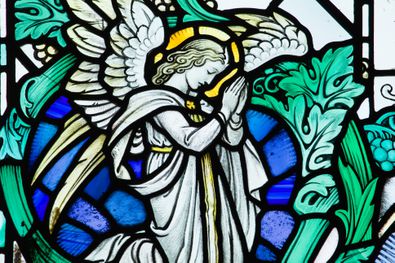
Quote:
Originally Posted by Mighty
Veil
What exactly is Theosophy
all about? I'm reading it on Wiki but that's not helping. I'm curious to
know because when my grandmother died years ago. In her book collection
I found a very old bible like book with the emblem of the Theosophical
Society symbol on it. The symbol has the Nazi symbol in it, so I always
wondered if there was some connection (not that grandma *ever* seemed like
the type).

Look up Sprirtism and Theosophy
online, also try Madam Blavatsky (sp?).
It was a popular belief
back in the late 1800s and lasted into the early 1900s, a spritualist sort
of belief.
As a matter of fact it was
very active in Wisconsin...and look up Wisconsin
Death Trip sometime. <the movie?>
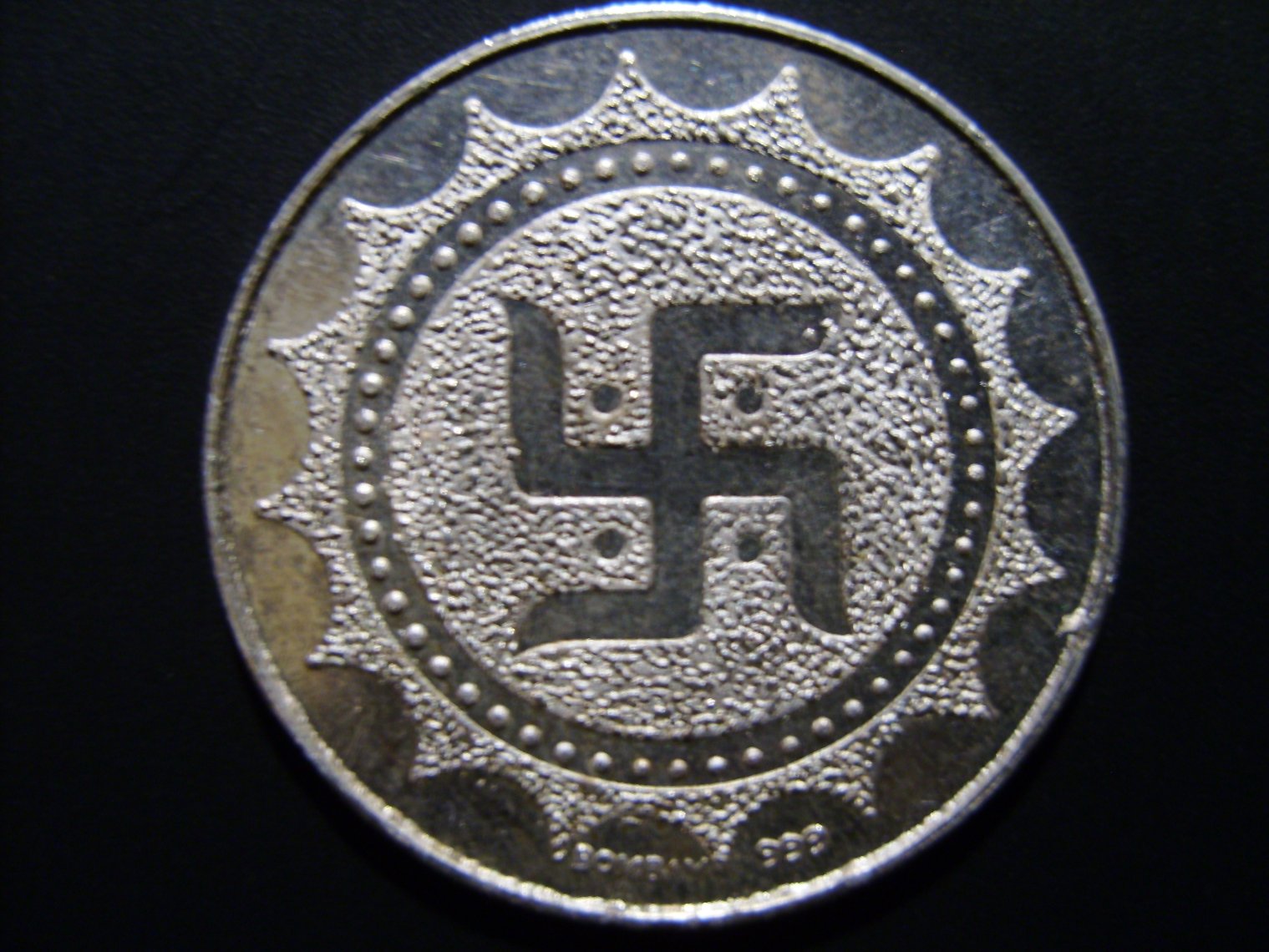
The swastika is a gammadon, IIRR, used in ancinet India and by the American indians as a good luck symbol.
Cheers,
Gary
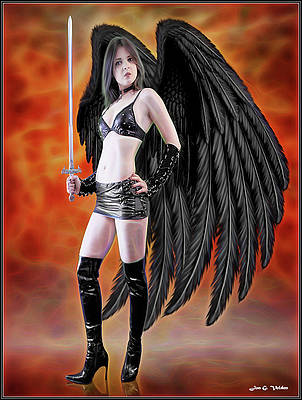
Quote:
Originally Posted by Mighty
Veil
Looking at Solar Symbols
at Wiki.
The Canadian flag looks
similar to the 8 pointed star.
Makes me wonder if that's
what it's suppose to be.
8 pointed star
http://en.wikipedia.org/wiki/Solar_symbols
Maple leaf flag
http://en.wikipedia.org/wiki/Maple_leaf_flag

Howdy,
I don't believe that solar
symbols are connected to the supposed Theophysical Solar
spirit creatire.
a sort of thing similar
to a Seraph,
just as the Planatar
is rougly equivalent to a Cherub.
Cheers,
Gary


Quote:
Originally Posted by dcas
Are there rough D&D
equivalents to each of the nine choirs of angels?
or was that not a consideration?

That was not a consideration,
the Devas, Planatars,
and Solars were added to the roster of
creatures to coulter-balance the various demone,
devils,
and fiends.
Cheerio,
Gary

"Take the first step in faith.
You don't have to see the
whole staircase.
Just take the first step."
- Martin Luther King Jr.
Dedicated
to Peter Steele